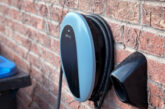
Julian Grant, Managing Director of Chauvin Arnoux, discusses the value of energy monitoring and measuring equipment as the demand on electrical systems continues to increase.
Many domestic installations today are seeing changes in the nature of the electrical equipment being installed in them, or requested to be installed in them, and notably the addition of some fairly high current loads, including most recently heat pumps and EV chargepoints.
Domestic air source heat pumps can typically consume from 3kW to 7kW (13A to 30A) of electricity, dependent on the size of the unit, the temperature settings, the weather conditions, and the thermal insulation efficiency of the property.
Add a single-phase home EV charger, which could require another 7kW (30A), and bearing in mind all of the other potential “electricity hungry” appliances in the installation, such as showers, water heaters, hot tubs, ovens, etc. and it’s easy to see the issue.
Full to capacity
In the best of cases the installation will already be served by a 100A main fuse, however, it is more likely that an 80A or even 60A fuse may be present. Either way, conventional maximum demand and diversity calculations, as described in the On-Site Guide, are increasingly revealing situations where a large part of the capacity may already be taken up, leaving insufficient headroom for any desired or required additional loads.
In the 60A/80A main fuse scenario, a larger fuse could be requested, but the immediate granting of these may not necessarily be straightforward, or cost-free, depending on the local supply capacity and the nature and rating of the equipment and cable feeding the property. So where does that leave the property owner and the electrical installer?
Well, there’s potentially another way to look at the maximum demand of the installation, referred to by the Energy Network Association (ENA) in their guidance on connecting electric vehicles and heat pumps to the network, and that is to measure and monitor it. In this scenario electricity demand data is measured and recorded, ideally over a two-week period at ten-minute intervals, before being analysed to arrive at an accurate maximum demand figure.
This “evidenced” load assessment will often reveal spare capacity, where diversity calculations did not, or at the least could indicate the times when spare capacity may be available. This could, for example, enable the fitting of a smart EV charger that incorporates load monitoring to ensure maximum demand isn’t exceeded, and with the knowledge that it will actually be able to charge an electric vehicle for significant periods of time without being throttled down.
A logger can get you out of the jam
A simple and non-intrusive way to monitor and measure energy use over time would be to temporarily install a modern portable energy logger (PEL), such as the PEL103 or PEL104 from Chauvin Arnoux. PELs can be installed quickly and non-intrusively at the distribution board, in many cases without even having to turn off the supply. They will log electrical energy data over any time period you choose – hours, days or weeks – so that you can get a detailed picture of the electricity usage.
But that’s not all a PEL will tell you. Another important concern with EV chargepoints, for example, are harmonics. The supply system is AC, but to charge a vehicle battery you need a DC supply, so at some point in the charging system – either in the charger itself or in the vehicle – there is going to be a rectifier. Rectifiers are inherently non-linear loads that generate harmonics, and if the harmonics in the installation are too great all sorts of strange anomalies, and a general reduction in the electrical efficiency of the installation, may occur.
A PEL will give you accurate information about any harmonics that already exist in the installation, perhaps as a result of LED lighting, IT equipment, or the plethora of other non-linear loads that exist today, once again logging this information over a period of time.
When it comes to retrieving information from a PEL, apart from the obvious process of going to the installation and downloading the contents from the instrument’s internal memory via a USB connection, the latest generation PEL104 from Chauvin Arnoux has been provided with additional communication options such as Wi-Fi, 3G and GPRS.
This makes it possible to establish a remote connection to the PEL, enabling analysis of the data from the comfort of your own office, and providing knowledge of the monitoring results prior to re-visiting the customer. This in turn means a considered proposal can be put together and presented when the product is retrieved.
Other useful applications
In other situations, having a PEL with remote data access makes it possible for users to set alarm limits for most key parameters and, if these are exceeded, the PEL can be set up to immediately alert them via the remote connection – whatever type that may be. In addition, the PEL can be configured to email reports of selected parameters at regular intervals chosen by the user.
As we’ve seen, a PEL is a very useful asset for load monitoring and maximum demand calculations when planning the installation of high-power electrical equipment, and also after the installation is complete, to verify that the loading and harmonics are within expected limits.
Apart from that, a PEL will effectively monitor and measure any supply you connect it to and can check for 3 phase voltage and current balance, frequency, power factor, harmonics, and any unexpected out-of-hours electrical usage. A truly useful tool that could add a lot to your business!
To browse the Chauvin Arnoux PEL100 series brochure, click here












